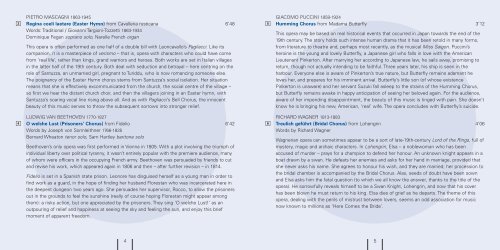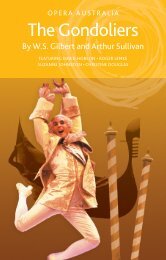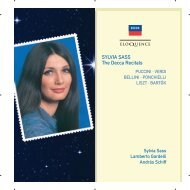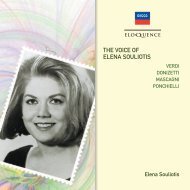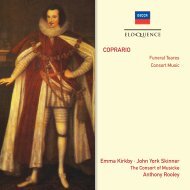Opera Choruses Booklet - Buywell
Opera Choruses Booklet - Buywell
Opera Choruses Booklet - Buywell
You also want an ePaper? Increase the reach of your titles
YUMPU automatically turns print PDFs into web optimized ePapers that Google loves.
PIETRO MASCAGNI 1863-1945<br />
3 Regina coeli laetare (Easter Hymn) from Cavalleria rusticana 6’48<br />
Words: Traditional / Giovanni Targioni-Tozzetti 1863-1934<br />
Dominique Fegan soprano solo, Narelle French organ<br />
This opera is often performed as one half of a double bill with Leoncavallo’s Pagliacci. Like its<br />
companion, it is a masterpiece of verismo – that is, opera with characters who could have come<br />
from ‘real life’, rather than kings, grand warriors and heroes. Both works are set in Italian villages<br />
in the latter half of the 19th century. Both deal with seduction and betrayal – here centring on the<br />
role of Santuzza, an unmarried girl, pregnant to Turiddu, who is now romancing someone else.<br />
The poignancy of the Easter Hymn chorus stems from Santuzza’s social isolation. Her situation<br />
means that she is effectively excommunicated from the church, the social centre of the village –<br />
so first we hear the distant church choir, and then the villagers joining in an Easter hymn, with<br />
Santuzza’s soaring vocal line rising above all. And as with Pagliacci’s Bell Chorus, the innocent<br />
beauty of this music serves to throw the subsequent sorrows into stronger relief.<br />
LUDWIG VAN BEETHOVEN 1770-1827<br />
4 O welche Lust (Prisoners’ Chorus) from Fidelio 6’42<br />
Words by Joseph von Sonnleithner 1766-1835<br />
Bernard Wheaton tenor solo, Sam Hartley baritone solo<br />
Beethoven’s only opera was first performed in Vienna in 1805. With a plot involving the triumph of<br />
individual liberty over political tyranny, it wasn’t entirely popular with the premiere audience, many<br />
of whom were officers in the occupying French army. Beethoven was persuaded by friends to cut<br />
and revise his work, which appeared again in 1806 and then – after further revision – in 1814.<br />
Fidelio is set in a Spanish state prison. Leonore has disguised herself as a young man in order to<br />
find work as a guard, in the hope of finding her husband Florestan who was incarcerated here in<br />
the deepest dungeon two years ago. She persuades her supervisor, Rocco, to allow the prisoners<br />
out in the grounds to feel the sunshine (really of course hoping Florestan might appear among<br />
them): a risky action, but one appreciated by the prisoners. They sing ‘O welche Lust!’ as an<br />
outpouring of relief and happiness at seeing the sky and feeling the sun, and enjoy this brief<br />
moment of apparent freedom.<br />
GIACOMO PUCCINI 1858-1924<br />
5 Humming Chorus from Madama Butterfly 3’12<br />
This opera may be based on real historical events that occurred in Japan towards the end of the<br />
19th century. The story holds such intense human drama that it has been retold in many forms,<br />
from literature to theatre and, perhaps most recently, as the musical Miss Saigon. Puccini’s<br />
heroine is the young and lovely Butterfly, a Japanese girl who falls in love with the American<br />
Lieutenant Pinkerton. After marrying her according to Japanese law, he sails away, promising to<br />
return, though not actually intending to be faithful. Three years later, his ship is seen in the<br />
harbour. Everyone else is aware of Pinkerton’s true nature, but Butterfly remains adamant he<br />
loves her, and prepares for his imminent arrival. Butterfly’s little son (of whose existence<br />
Pinkerton is unaware) and her servant Suzuki fall asleep to the strains of the Humming Chorus,<br />
but Butterfly remains awake in happy anticipation of seeing her beloved again. For the audience,<br />
aware of her impending disappointment, the beauty of this music is tinged with pain. She doesn’t<br />
know he is bringing his new, American, ‘real’ wife. The opera concludes with Butterfly’s suicide.<br />
RICHARD WAGNER 1813-1883<br />
6 Treulich geführt (Bridal Chorus) from Lohengrin 4’06<br />
Words by Richard Wagner<br />
Wagnerian opera can sometimes appear to be a sort of late-19th-century Lord of the Rings, full of<br />
mystery, magic and archaic characters. In Lohengrin, Elsa – a noblewoman who has been<br />
accused of murder – prays for a champion to defend her honour. An unknown knight appears in a<br />
boat drawn by a swan. He defeats her enemies and asks for her hand in marriage, provided that<br />
she never asks his name. She agrees to honour his wish, and they are married; her procession to<br />
the bridal chamber is accompanied by the Bridal Chorus. Alas, seeds of doubt have been sown<br />
and Elsa asks him the fatal question (to which we all know the answer, thanks to the title of the<br />
opera). He sorrowfully reveals himself to be a Swan Knight, Lohengrin, and now that his cover<br />
has been blown he must return to his king. Elsa dies of grief as he departs. The theme of this<br />
opera, dealing with the perils of mistrust between lovers, seems an odd association for music<br />
now known to millions as ‘Here Comes the Bride’.<br />
4<br />
5


